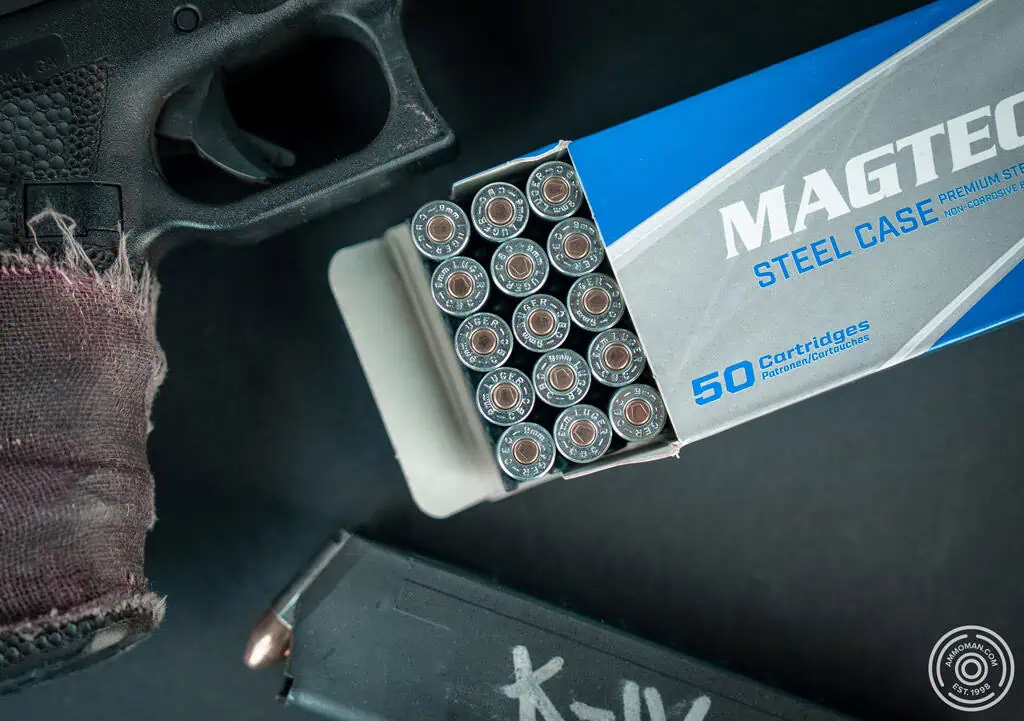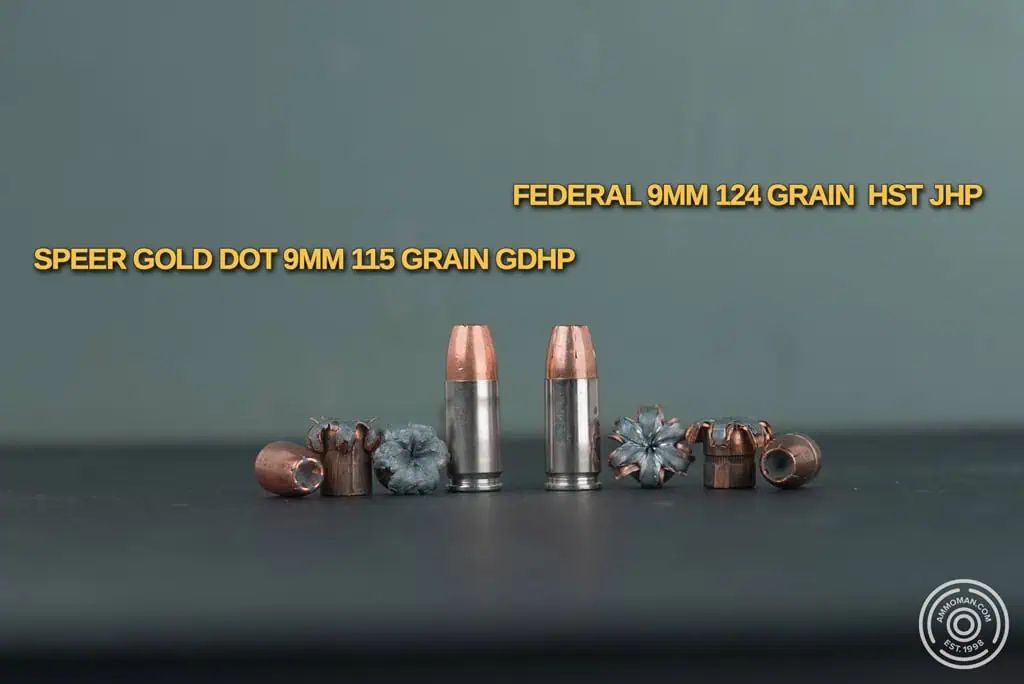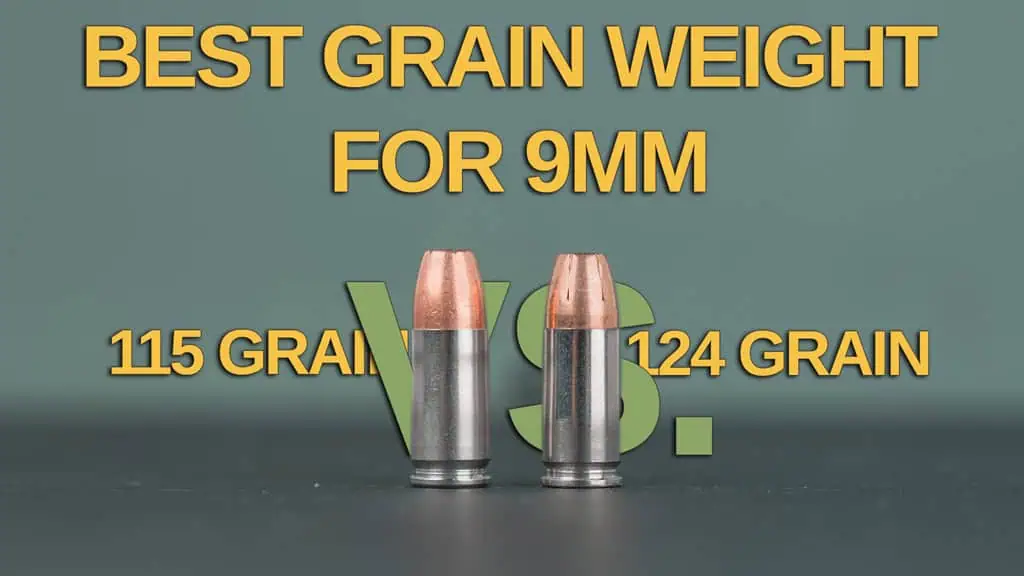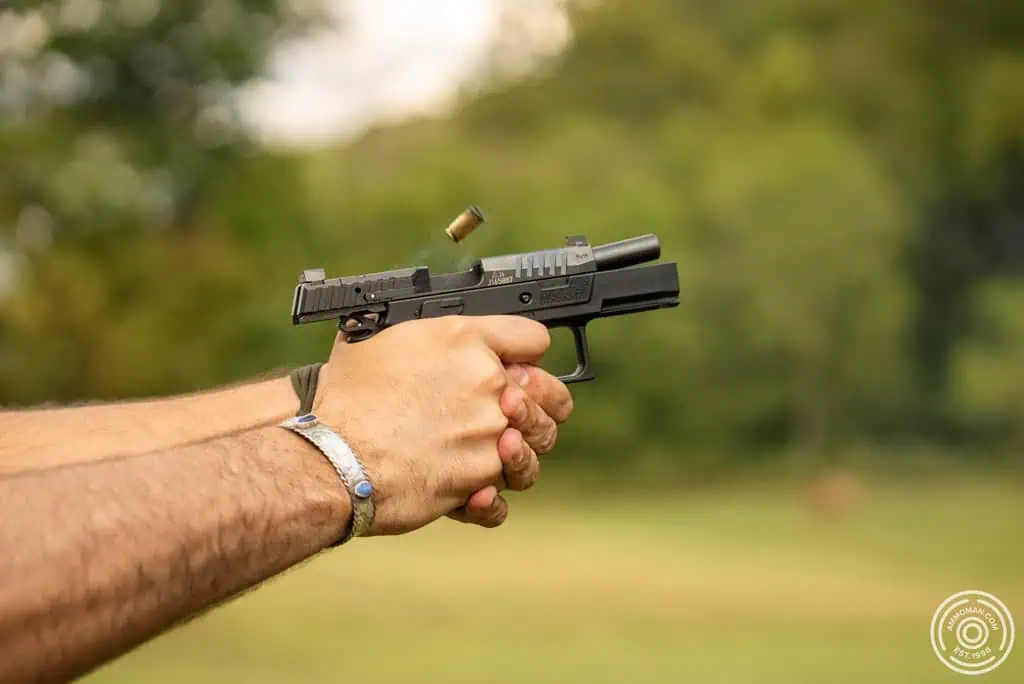The 9mm Luger, being the most popular handgun cartridge in the country, comes in a vast variety. This includes bullets of numerous weights, from loads packing 43 grains of birdshot to rounds loaded with a 165-grain bullet.
The majority, however, are either 115 or 124 grains. From full metal jackets to advanced self-defense expanding loads, roughly two-thirds of 9mm ammo is one of these two sizes.
This is why so many people, especially newcomers to the cartridge, wonder about the differences between these two sizes. Can 9 grains really make a difference in ballistic performance?

Magtech 115 grain steel cased 9mm is perfect for training on the range.
To find out, we need to examine the stats for these two grain weights. But first, it helps to briefly review the basics of bullet weights and measurements so we better understand the 115- vs 124-grain debate.
Beginner’s Lesson: What is “Grain Weight”
When looking at a box of cartridges, you’ll see “grains” or the abbreviation “gr.” A grain, which equals 1/7000th of a pound, is the standard unit of measurement used for weighing a bullet.
The weight of a bullet impacts how the bullet travels through the air, how fast it’s going, and how it performs on impact. It’s one of the most important considerations when you are purchasing ammo or selecting a cartridge for hunting, target shooting, and personal defense.
The difference between these two sizes is nine, which means the difference is 9/7,000ths of a pound. Less than 1/700th of a pound, and yet it will have a noticeable difference in the precise physics of ammunition ballistics.
115-grain vs 124-grain: Ballistics
Velocity
| 9mm Luger Product | Muzzle (fps) | 25 yards | 50 yards |
|---|---|---|---|
| 115 grain Speer Gold Dot |
1,210 | 1,133 | 1,071 |
| 124 grain Speer Gold Dot |
1,150 | 1,092 | 1,044 |
| 115 grain Remington Range FMJ |
1,145 | 1,092 | 1,048 |
| 124 grain Remington Range FMJ |
1,110 | 1,068 | 1,031 |
| 115 grain Federal Premium FMJ |
1,180 | 1,106 | 1,048 |
| 124 grain Federal Premium FMJ |
1,150 | 1,095 | 1,049 |
| 115 grain Hornady Black XTP |
1,155 | N/A | 1,038 |
| 124 grain Hornady Black XTP |
1,110 | N/A | 1,027 |
If all other factors are the same, a lighter bullet will have a faster muzzle speed. This is a predictable advantage for a 115-grain projectile, as this size almost always has a higher muzzle velocity. The advantage, however, is minimal. Most of the 115-grain rounds have a speed advantage of roughly 30 to 50 fps; hardly a difference maker.
Despite starting slower, a heavier bullet maintains kinetic force for a longer distance. Therefore, at 25 or 50 yards we often see 124-grain rounds catching up with their 115-grain counterparts.
Speed goes to the 115-grain round, but it’s not a massive difference; certainly not one that would drive your ammo decisions. But what about energy? Does nine grains of weight create a noticeable difference in power?
Energy
| Muzzle (ft-lbs) | 25 yards | 50 yards | |
|---|---|---|---|
| 115 grain Speer Gold Dot |
374 | 328 | 293 |
| 124 grain Speer Gold Dot |
364 | 328 | 300 |
| 115 grain Remington Range FMJ |
335 | 305 | 280 |
| 124 grain Remington Range FMJ |
339 | 314 | 293 |
| 115 grain Federal Premium FMJ |
356 | 312 | 280 |
| 124 grain Federal Premium FMJ |
364 | 330 | 303 |
| 115 grain Hornady Black XTP |
341 | N/A | 234 |
| 124 grain Hornady Black XTP |
339 | N/A | 257 |
One could, with good reason, assume that the 124-grain rounds would seriously overpower the 115-grain options. This is not the case. In fact the muzzle velocities are split: two of our comparisons go to 115, two to 124.
Downrange we do see an advantage for the 124, as the heavier bullet maintains its speed, helping to deliver more force into the target. But once again it’s not a massive advantage; we can’t honestly say that the 124 grain out-powers the 115.
Penetration and Terminal Expansion
| 124 Grains | Penetration (inches) |
Diameter (inches) |
Muzzle Velocity (fps) |
|---|---|---|---|
| Federal JHP | 18.3 | 0.5 | 1,121 |
| Hornady Critical Defense | 13.62 | 0.52 | 1,064 |
| Hornady American Gunner | 17.72 | 0.49 | 1,032 |
| Federal Train & Protect | 33.28 | 0.35 | 1,074 |
| Speer LE Gold Dot | 33.38 | 0.35 | 1,079 |
| Federal LE Hi-Shok JHP | 25.44 | 0.36 | 1,086 |
| MAGTECH Guardian Gold +P | 14.36 | 0.58 | 1,166 |
| Barnes TAC-XP +P | 11.78 | 0.7 | 955 |
| Carbon DPX +P | 12.3 | 0.68 | 1,046 |
| Black Hills XP +P | 13.76 | 0.69 | 1,084 |
| Black Hills JHP +P | 18.38 | 0.48 | 1,112 |
| Average | 19.02 | 0.59 | 1,074 |
| 124 Grains | Penetration (inches) |
Diameter (inches) |
Muzzle Velocity (fps) |
| Hornady Custom XTP HP | 21.96 | 0.44 | 1,005 |
| Federal LE Tactical Hydra-Shok | 29.12 | 0.36 | 1,008 |
| Federal LE Tactical HST +P | 18.72 | 0.68 | 1,106 |
| MAGTECH Guardian Gold | 19.44 | 0.38 | 1,032 |
| MAGTECH First Defense | 31.54 | 0.35 | 1,076 |
| Winchester Defender +P | 23.38 | 0.47 | 1,044 |
| Black Hills JHP | 20.96 | 0.45 | 1,055 |
| Speer Gold Dot Personal Protection +P | 18.58 | 0.44 | 1,090 |
| Sig Sauer Elite Performance JHP | 19.26 | 0.47 | 1,116 |
| Remington Golden Saber +P | 16.02 | 0.57 | 1100 |
| Speer Gold Dot LE +P | 19.62 | 0.51 | 1110 |
| Federal LE Tactical HST | 18.46 | 0.62 | 1054 |
| Average | 21.42 | 0.48 | 1,066 |
Energy and velocity matter, but if you’re using a 9mm handgun for personal protection and concealed carry, you need to consider penetration and bullet expansion. The FBI, after all, looks at bullet penetration in ballistic gel to measure the effectiveness of a round. They don’t, as far as we know, look at velocity and energy.

Expanded Rounds from Speer Gold Dot 115 grain (left) and Federal 124 grain (right)
Testing of 115 and 124 grain 9mm loads gave us a ton of data to sort through. We fired the ammo into synthetic ballistic gelatin and a 4-layer cloth barrier.
The results show that the 115 loads penetrated an average of 19.02 inches with bullets mushrooming to an average of 0.59 inches, while the 124 rounds penetrated to 21.42 with a diameter of 0.48.
So, for whatever reason, it appears the 115-grain rounds actually expand to a larger diameter while still maintaining excellent penetration. Expansion, it seems, could be the defining factor for 115- vs 124-grain rounds.
(The FBI testing system is based on points. For example, rounds get 10 points if they reach 14 to 15.9 inches of penetration. But to limit over-penetration, if they go beyond 19 inches they only get five points.)
Recoil Between 115 and 124 Grain Ammo
Felt recoil is a matter of personal use and preference. While the 124-grain round is larger and has more energy, many feel that recoil is actually more manageable. Some report that the gun pushes instead of snaps, so follow-up shots are easier with the heavier round.
Ultimately, the best bullet weight depends on your weapon and your personal preferences. In nearly all cases, it helps to try both sizes and see which performs best. Which grain weight gives you the tightest accuracy? Which feels better? Testing different sizes is the only way to decide between a 115- and a 124-grain round.






